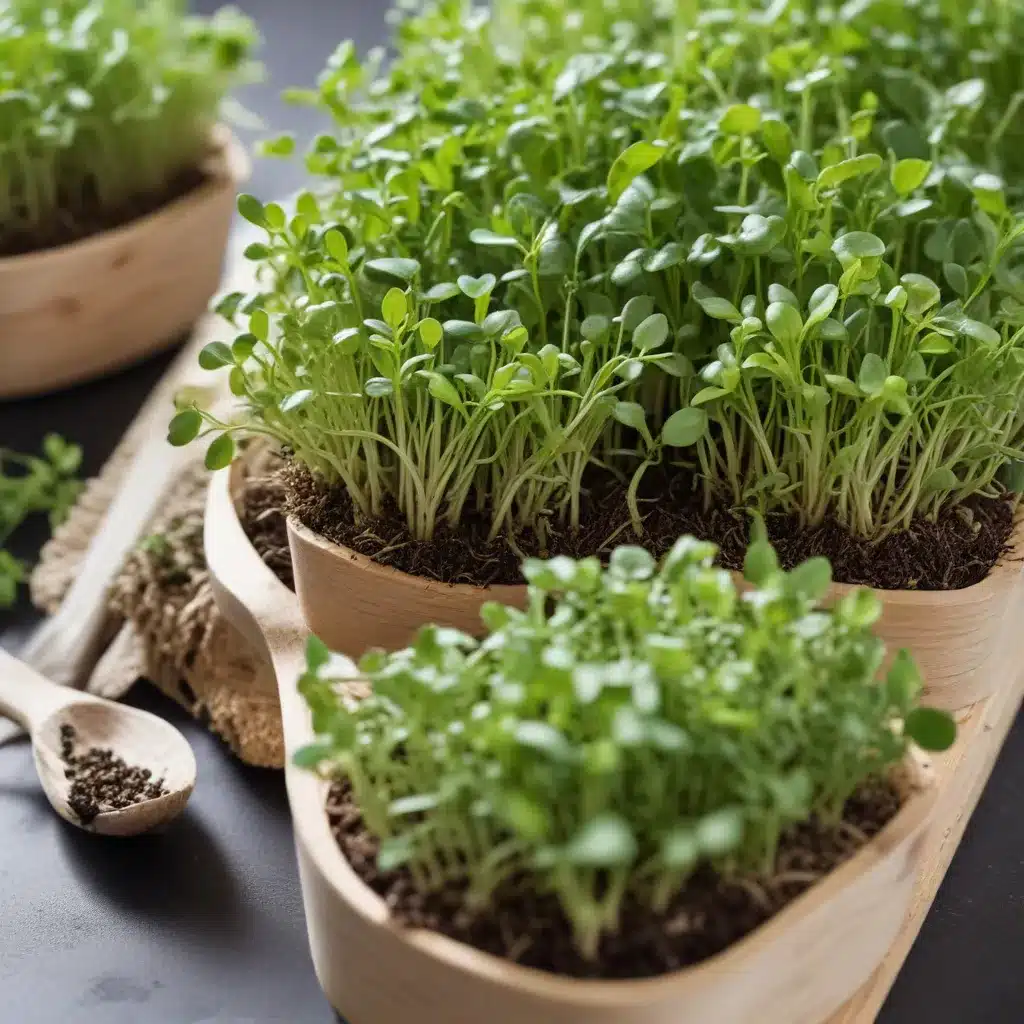
Growing Microgreens: Tiny Powerhouses of Nutrition
Tucked away in the corner of our greenhouse, you’ll find a thriving garden of miniature marvels—our microgreen patch. These delicate, nutrient-dense plants may be small in size, but they pack a powerful punch when it comes to flavor and nutrition. At Crooked Pines Farm, we’ve embraced the joys of growing and enjoying microgreens, and we’re eager to share their wonders with you.
Nutritional Profile of Microgreens
What exactly sets microgreens apart? These young, edible plants are harvested just 7 to 21 days after germination, when they’ve developed their first set of true leaves. Unlike sprouts, which are harvested even earlier, microgreens have had more time to develop a robust root system and absorb a higher concentration of vitamins, minerals, and antioxidants from their growing medium.
Studies have shown that microgreens can contain up to 40 times more nutrients than their mature counterparts. They’re bursting with vitamins A, C, E, and K, as well as essential minerals like iron, magnesium, and zinc. What’s more, microgreens are rich in beneficial plant compounds called phytochemicals, which have been linked to reduced risk of chronic diseases.
The antioxidant power of microgreens is truly remarkable. These tiny greens contain a concentrated dose of antioxidants that can help neutralize harmful free radicals, reducing inflammation and oxidative stress in the body. This makes microgreens an excellent choice for supporting overall health and well-being.
Types of Microgreens
When it comes to microgreens, the possibilities are endless. At Crooked Pines, we grow a diverse array of varieties, each with its own unique flavor profile and visual appeal. Some of our most popular microgreens include:
- Arugula: Peppery and spicy
- Basil: Sweet and aromatic
- Broccoli: Mild and slightly bitter
- Radish: Crisp with a strong, spicy kick
- Cilantro: Fresh and citrusy
We also experiment with more unique microgreen varieties, such as purple cabbage, wasabi, and sunflower. The vibrant colors and unexpected flavors of these specialty microgreens can truly elevate any dish.
When selecting microgreen seeds, it’s important to choose high-quality, non-GMO varieties from a reputable supplier. This ensures you’re getting the healthiest, most nutrient-dense plants possible.
Growing Microgreens Indoors
One of the best things about microgreens is that they can be grown year-round, even in small spaces. At our farm, we’ve set up a dedicated microgreen growing area in our greenhouse, but you can easily cultivate these tiny powerhouses right in your own home.
The key to successful indoor microgreen growing is providing the right growing medium, lighting, and climate conditions. We prefer to use a soil-based substrate, like a potting mix or coco coir, which allows the roots to thrive and absorb essential nutrients. Alternatively, you can also grow microgreens hydroponically, using a nutrient-rich water solution.
Sowing the seeds is a straightforward process. Scatter the tiny seeds evenly over the growing medium, gently press them in, and mist the surface with water. Keep the soil consistently moist, but not waterlogged, during the germination phase.
Proper lighting is crucial for microgreen growth. Aim for 12 to 16 hours of full-spectrum LED grow lights placed 6 to 12 inches above the plants. The combination of red and blue light wavelengths will encourage strong stem and leaf development.
Maintaining the right temperature and humidity levels is also important. The ideal growing conditions for microgreens are 65 to 75°F (18 to 24°C) with moderate humidity. Good air circulation will help prevent issues like mold or damping off.
Harvesting and Storage
Once your microgreens reach 1 to 3 inches tall, usually within 1 to 3 weeks, they’re ready to harvest. Use sharp scissors or shears to cut the stems just above the soil line, leaving the roots and a small portion of the stem intact. This gentle harvesting method helps preserve the delicate leaves and maximize the shelf life of your microgreens.
After harvesting, it’s important to handle your microgreens with care. Store them in the refrigerator in a breathable container, such as a perforated plastic bag or clamshell, to maintain their freshness and prevent wilting. With proper storage, your microgreens can last up to 10 days, allowing you to enjoy their vibrant flavors and nutrition throughout the week.
Culinary Applications of Microgreens
The versatility of microgreens makes them a true kitchen superstar. Their bright colors, intense flavors, and crunchy textures can transform any dish into a culinary masterpiece. At Crooked Pines, we love to incorporate these miniature marvels into our meals in a variety of ways.
Start by adding a handful of microgreens to your salads for a burst of flavor and visual appeal. Their peppery, sweet, or earthy notes can elevate even the simplest greens. Sprinkle microgreens over sandwiches, wraps, and avocado toast for a fresh and nutritious crunch.
Blend microgreens into smoothies or juices for an extra nutrient boost, or use them as a garnish for soups, omelets, and even pizzas. Their delicate texture and concentrated flavors can truly make a dish shine.
When it comes to pairing microgreens, the possibilities are endless. Pair peppery arugula with roasted beets and creamy goat cheese, or top your roasted sweet potato with nutty sunflower microgreens. The combinations are limited only by your imagination.
At Crooked Pines, we believe that growing and enjoying microgreens is a true delight. These tiny powerhouses of nutrition not only elevate the flavors of our meals but also provide our family with a wealth of health benefits. We invite you to explore the world of microgreens and discover the myriad ways they can enrich your culinary adventures and nourish your body.
For more information on growing and using microgreens, be sure to visit our website at https://www.crookedpinesfarm.com. Our team of farm educators is always happy to share their expertise and help you unlock the full potential of these miniature marvels.


